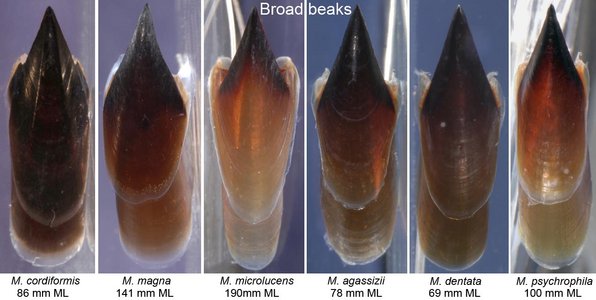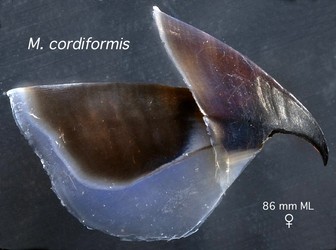We examined beaks from all mastigoteuthid species but lacked sufficient numbers of beaks to adequately characterize each species. Nevertheless, we have reached some tentative conclusions.
LOWER BEAKS
All mastigoteuthid lower beaks have a wing fold that in nearly all species obscures the jaw angle when viewed from the side.
Mastigoteuthid lower beaks can be separated into three major groups when viewed in profile: (1) slender beaks, (2) intermediate beaks and (3) broad beaks. To measure slenderness we used two measures, the beak length near the top of the beak (the crest length) and the length at the bottom of the beak (the baseline), which we compare to the beak height. The first measure was the most effective at separating the groups. Height was measured as the distance from the rostral tip to the baseline.
Slender, tall beak-species (Echinoteuthis atlantica, Echinoteuthis famelica, Mastigopsis hjorti and Mastigotragus pyrodes) have:
- average height/crest-length ratios of 1.70-1.82;
- average height/baseline ratios of 1.01-1.13. They, also, are narrow with a shorter span between jaw-angle points than other mastigoteuthids.
Intermediate species (all three species of Mastigoteuthis) have:
- average height/crest-length ratios of 1.58-1.62;
- average height/baseline ratios of 0.90-0.98.
Low, broad beak-species (Magnoteuthis spp., Idioteuthis cordiformis) have:
- average height/crest-length ratios of 1.21-1.36;
- average height/baseline ratios of 0.85-0.95.
The beaks of Echinoteuthis atlantica and Echinoteuthis famelica are the most slender and can easily be confused with beaks of Chiroteuthis. The jaw edge is straight then strongly curves to a slender and sharp rostral tip. All four species have a strong lateral-wall ridge.
Members of Mastigoteuthis have a similar appearance although considerable variation occurs within M. agassizii which may be a species complex. All species have a strong lateral-wall ridge and an intermediate width between jaw-angle points.
The broad beak species have a distinctive shape and broad lateral wall folds (Magnoteuthis magna, Idioteuthis cordiformis) or ridges (Magnoteuthis microlucens) that are very different from other members of the family. Idioteuthis cordiformis differs from the other two species in, among other features, the height of the hood above the crest.
UPPER BEAKS
Echinoteuthis danae and E. tyroi are only known from paralarvae and are not considered here.
Mastigoteuthid upper beaks prior to full pigmentation exhibit characteristic pigmentation on the lateral wall: The posterodorsal region of the beak is pigmented while the anteroventral region is clear and unpigmented. The slanting pigment margin is approximately continuous with the lower edge of the pigmented inner shoulder blade. This pigmentation is most clearly seen in the side views of Echinoteuthis atlantica and Idioteuthis cordiformis of those pictures seen below. This type of early pigmentation is also commonly seen in histioteuthids.
Most mastigoteuthid upper beaks can be separated into groups based on the beak width: slender-beak species with a narrow rostrum-hood and narrow crest and broad-beak species with a broad rostrum-hood and broad crest. The difference is apparent at first glance but somewhat difficult to quantify. We have measured the maximum width across the hood and compared this measure with the distance between this line and the tip of the rostrum.
Slender-beak species (Echinoteuthis atlantica, E. famelica and Mastigopsis hjorti) have a width ratio of 0.55-0.59.
One species, Mastigotragus pyrodes, is intermediate in width as its width radio (0.65) fell between the two major groups.
Broad-beak species (Mastigoteuthis agassizii, M. psychrophila , M. dentata, Magnoteuthis magna, Mg. microlucens, Idioteuthis cordiformis) have a width ratio of 0.71-0.78.
Slender-beak species:
The beaks of Echinoteuthis famelica and E. atlantica are very similar. Based on the few beaks examined, they can tentatively be separated by a twist in the shoulder padding below the outer shoulder blade which is unique to E. famelica. These two species are similar to Mastigopsis hjorti but are easily distinguished by the lower height of the crest beneath the hood (see below) and by the lack of a medial taper to the jaw wall which is strong in Mp. hjorti.
The three slender-beak species are most similar to Mastigotragus pyrodes which is intermediate in width between slender-beak species and broad-beak species. The hood depth (relative to the PRL) is greater (0.53, n=5) in Mt. pyrodes than in the three narrow beak species (combined ratio: 0.44, n=6).
Broad-beak species
Idioteuthis cordiformis is one of the more distinctive species.
In Idioteuthis cordiformis the height of the hood above the crest relative to the beak length (C-Ht/Ct-Rt) is the largest of any mastigoteuthid : I. cordiformis (0.22) compared to (0.14-0.18) for all other species. The OSB is deeper and extends anteriorly beyond the ISB which also lacks a distinct plateau. As in species of Magnoteuthis, the palete is nearly flat while in other mastigoteuthids the palete is strongly concave.
Species of the Magnoteuthis are also distinctive.
The most obvious feature of Magnoteuthis species is the low height of the crest within the rostrum (PD/P-H), a feature which they share with Idioteuthis cordiformis. We arrange mastigoteuthid species for this character as follows:
- Low: Idioteuthis cordiformis (0.55), Magnoteuthis microlucens (0.47), Mg. magna (0.59).
- Intermediate: Mastigoteuthis agassiz (0.79), M. dentata (0.77), M. psychro (0.69), Echinoteuthis atlantica (0.74), E. famelica (0.72).
- High intermediate: Mastigotragus pyrodes (0.93).
- High: Mastigopsis hjorti (1.12).
We recognize only a single feature, at present, that seems to separate Magnoteuthis magna from Mg. microlucens: a distinct cartilage-like bump or thickness at the base of the shoulder.

Figure. Slightly oblique side view of Magnoteuthis microlucens, mature male, 215 mm ML. Arrows point to the distinguishing feature which is not always this distinct.
The remaining broad-beak species (Mastigoteuthis agassizii, M. psychrophila and M. dentata) are difficult to separate in the whole animal. The uppper beaks cannot be reliably distinguished at this point perhaps due to the small number of beaks examined and the considerable variability found.














 Go to quick links
Go to quick search
Go to navigation for this section of the ToL site
Go to detailed links for the ToL site
Go to quick links
Go to quick search
Go to navigation for this section of the ToL site
Go to detailed links for the ToL site